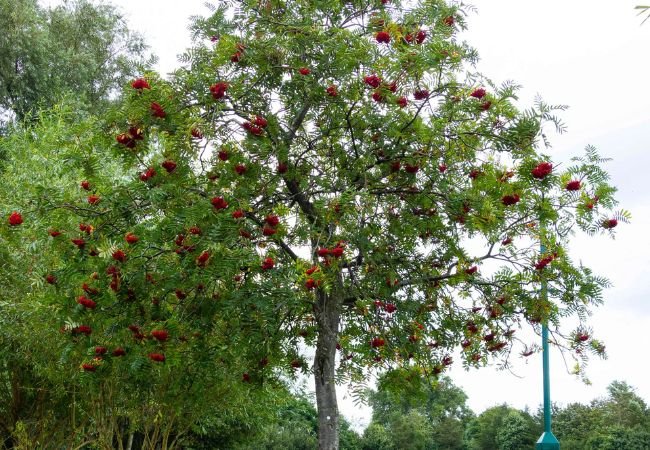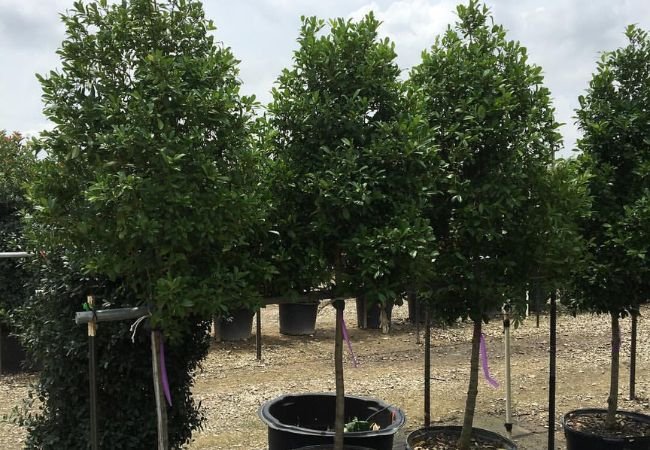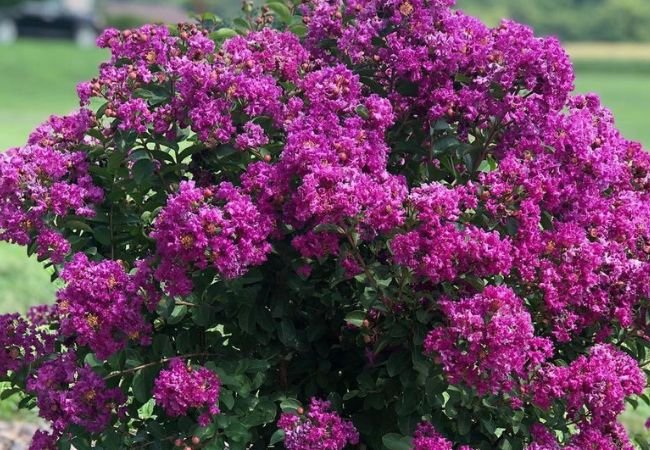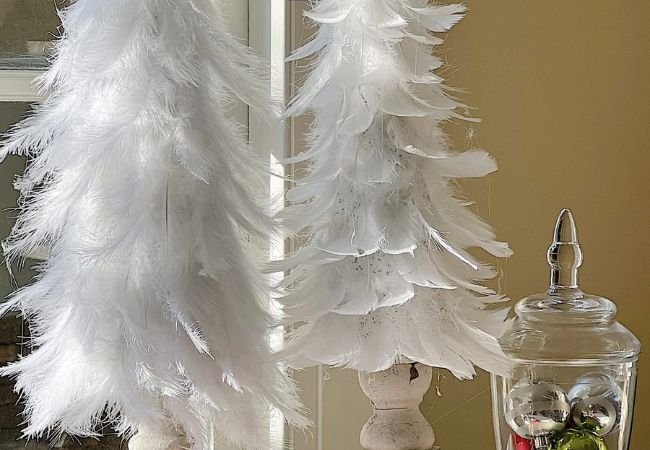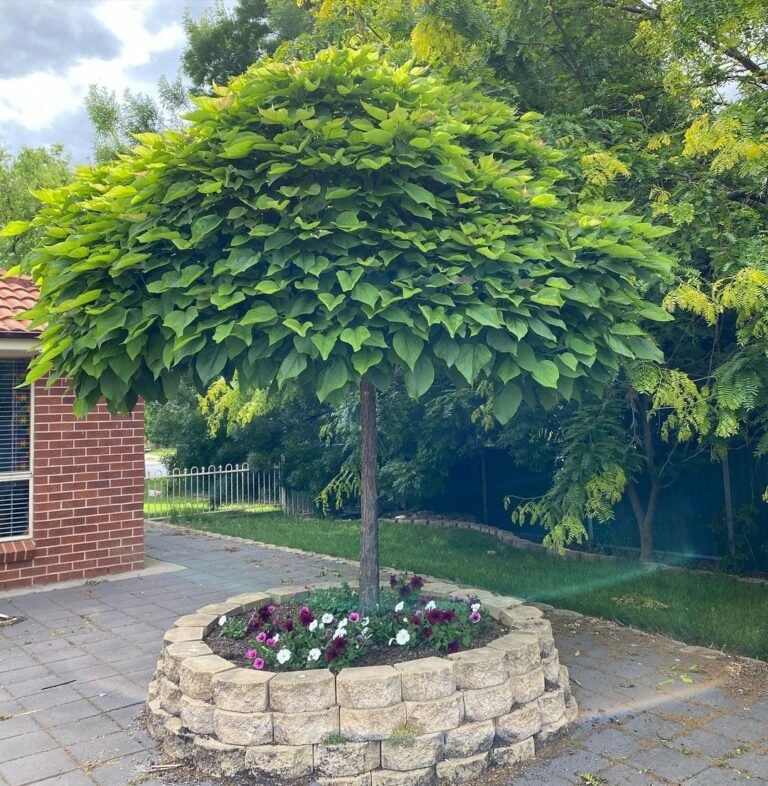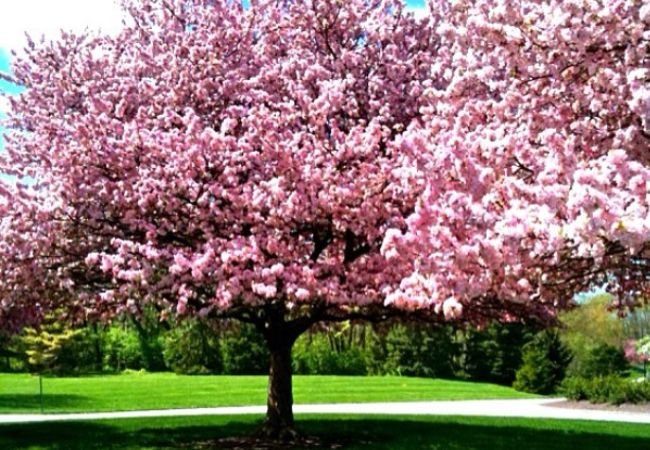Trees That Start with ‘B’: A Guide to Breathtaking Beauty
Embark on a journey of natural splendor with our guide to Trees that start with ‘B’. From majestic Beeches to vibrant Blossoms, explore their unique characteristics and learn how to cultivate these stunning specimens in your garden for enduring beauty.
Trees are amazing. They make our world prettier and help keep our air clean. Today, we’re going to learn about trees that start with the letter ‘B’. These trees are special and have many cool features. Let’s explore them together!
1. Beech (Fagus)
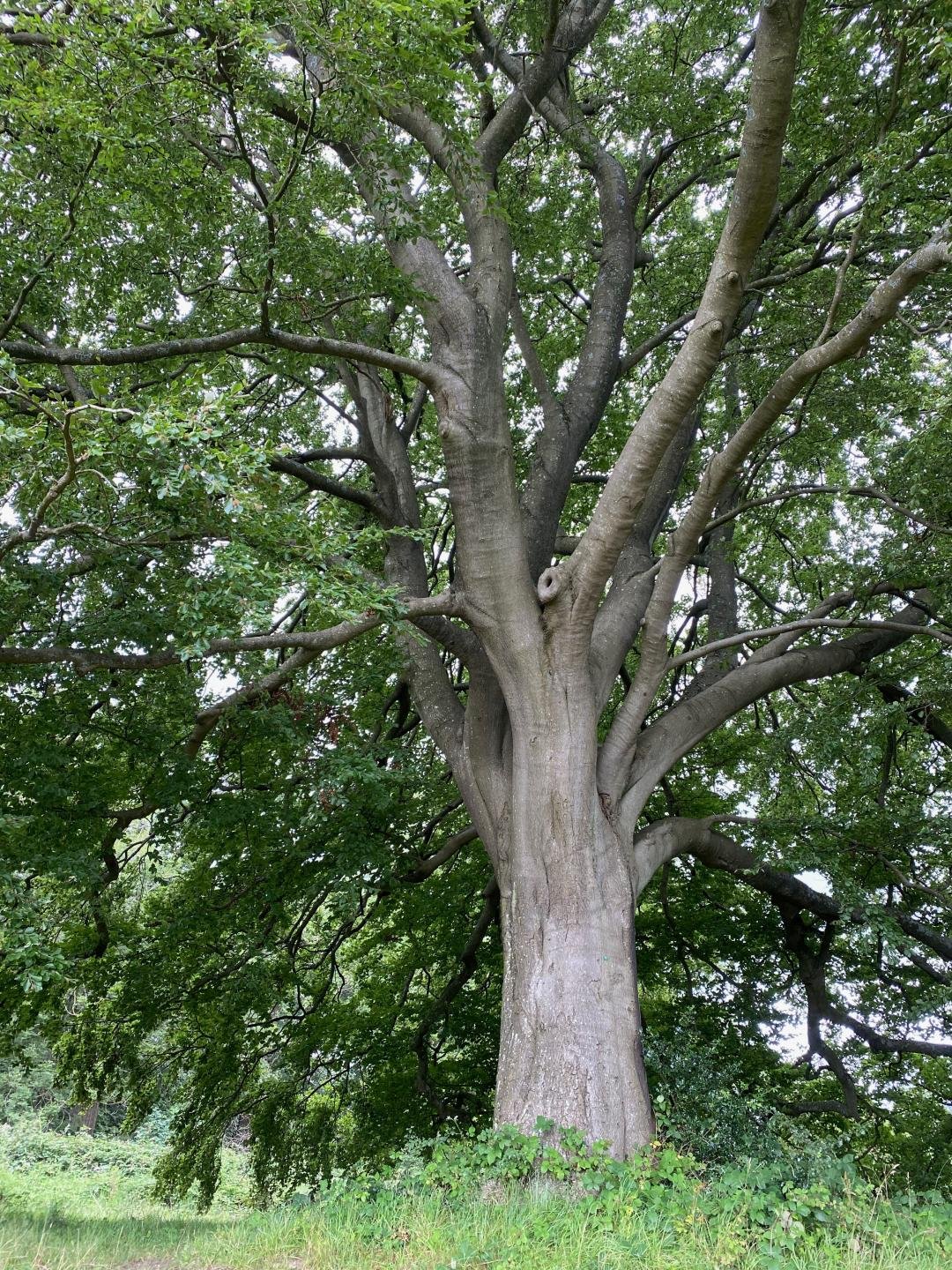
Here’s a short information chart about the Beech tree (Fagus):
| Common Name | Beech |
|---|---|
| Scientific Name | Fagus |
| Family | Fagaceae |
| Native To | Temperate regions of Europe, Asia, and North America |
| Description | Large deciduous tree with smooth, silver-gray bark; oval-shaped, toothed leaves that turn golden-bronze in autumn |
| Height | Typically grows 50-80 feet tall, but can reach up to 130 feet |
| Fruit/Nuts | Produces triangular beechnuts enclosed in a spiky husk; important food source for wildlife |
| Wood | Valued for its hardness and durability; used in furniture, flooring, and tool handles |
| Ecological Role | Provides habitat and food for various wildlife species; contributes to forest ecosystems |
| Cultural Significance | Historical use in folklore, woodworking, and medicinal preparations |
| Conservation Status | Generally stable, although specific species may be threatened in localized regions |
Beech trees are big and beautiful. They have smooth, gray bark that looks like elephant skin. Beech leaves are oval-shaped and turn golden in fall.
These trees can live for a very long time. Some Beech trees are over 300 years old!
Beech trees make small nuts called beechnuts. Many animals like to eat these nuts. People can eat them too, but they’re very small.
2. Birch (Betula)
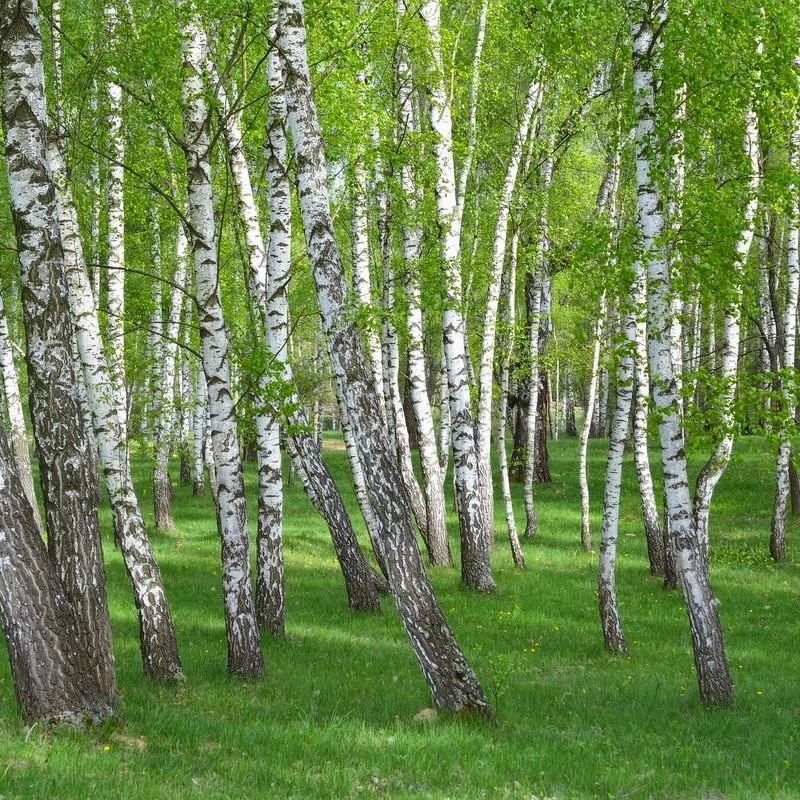
Here’s a short information chart about the Birch tree (Betula):
| Common Name | Birch |
|---|---|
| Scientific Name | Betula |
| Family | Betulaceae |
| Native To | Northern temperate and boreal regions of the Northern Hemisphere |
| Description | Medium-sized deciduous tree with distinctive papery bark that peels in thin, horizontal strips; small, serrated leaves |
| Height | Typically grows 40-50 feet tall, but some species can reach up to 100 feet |
| Fruit | Small, winged seeds (samara) clustered in cone-like structures |
| Wood | Pale, fine-grained wood used in furniture, flooring, and crafts; burns well and is used for firewood |
| Ecological Role | Pioneer species in forest succession; provides food and habitat for various wildlife species |
| Cultural Significance | Symbolic tree in many cultures; traditionally used in construction, crafting (birch bark canoes), and as a source of medicine |
| Conservation Status | Generally stable, although certain species may be threatened by habitat loss or climate change |
Birch trees are easy to spot. They have white or silver bark that peels off in thin layers. Birch leaves are shaped like triangles and turn bright yellow in fall.
There are many types of Birch trees. The Paper Birch is famous for its white bark. The River Birch has bark that’s more pinkish-brown.
Birch trees are important for wildlife. Many birds and small animals use them for food and homes.
3. Blackwood (Acacia melanoxylon)
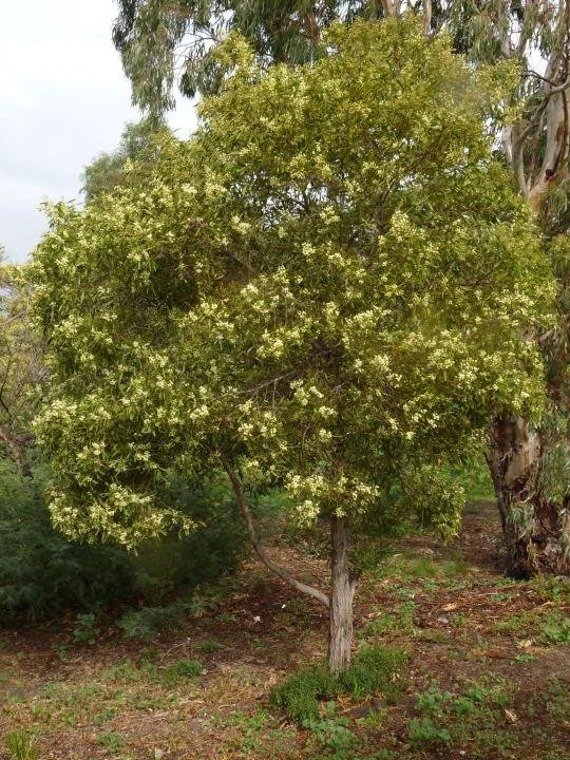
Here’s a short information chart about Blackwood (Acacia melanoxylon):
| Common Name | Blackwood |
|---|---|
| Scientific Name | Acacia melanoxylon |
| Family | Fabaceae (Leguminosae) |
| Native To | Southeastern Australia and Tasmania |
| Description | Medium to tall evergreen tree with dark brown to black heartwood; feathery bipinnate leaves and pale yellow flowers in clusters |
| Height | Typically grows 20-30 meters (65-100 feet) tall, occasionally up to 45 meters (150 feet) |
| Wood | Highly valued for its dark, dense, and durable timber; used in fine furniture making, cabinetry, flooring and musical instruments |
| Ecological Role | Provides habitat and food for various wildlife species; contributes to forest ecosystems |
| Cultural Significance | Important timber tree in Australia; historically used by indigenous Australians for tools and weapons |
| Conservation Status | Not globally threatened, but local populations may be affected by habitat loss and invasive species |
Blackwood trees come from Australia. They’re also called Australian Blackwood. These trees have dark, hard wood that people use to make furniture and musical instruments.
Blackwood trees have leaves that look more like long, flat needles. They make fluffy, yellow flowers that smell nice.
These trees grow fast and can live in many different places. That’s why some people plant them outside of Australia too.
4. Buckeye (Aesculus)
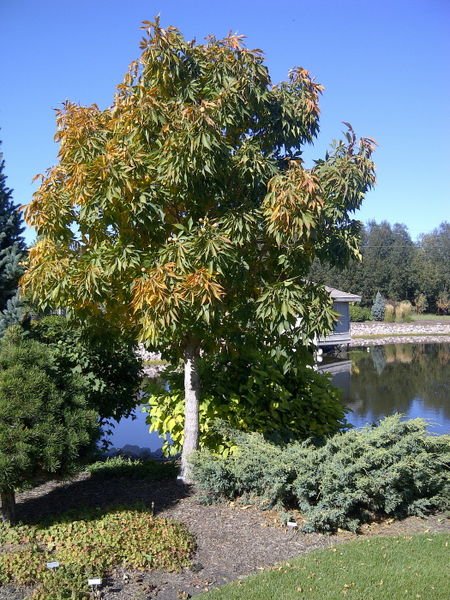
Here’s a short information chart about Buckeye (Aesculus):
| Common Name | Buckeye |
|---|---|
| Scientific Name | Aesculus |
| Family | Sapindaceae |
| Native To | North America, Europe, and Asia |
| Description | Deciduous tree or shrub with palmately compound leaves; showy, upright clusters of flowers in spring |
| Height | Typically grows 20-50 feet tall, depending on species |
| Fruit | Round, leathery capsule containing 1-3 large seeds (buckeyes), often glossy and mahogany-colored |
| Wood | Not highly valued for timber due to softness and lightweight nature; occasionally used for small woodworking projects |
| Ecological Role | Provides food for wildlife; important in forest ecosystems |
| Cultural Significance | Symbolic tree in some cultures; seeds historically used by Native Americans for food and medicinal purposes |
| Conservation Status | Generally stable; some species may face localized threats due to habitat loss or invasive species |
Buckeye trees are named for their nuts, which look like the eye of a deer. These trees have big leaves shaped like hands and make pretty flowers in spring.
The nuts from Buckeye trees are not good to eat. But they’re fun to collect because they’re so shiny and smooth.
Ohio is called “The Buckeye State” because these trees used to grow all over the state.
5. Baobab (Adansonia)
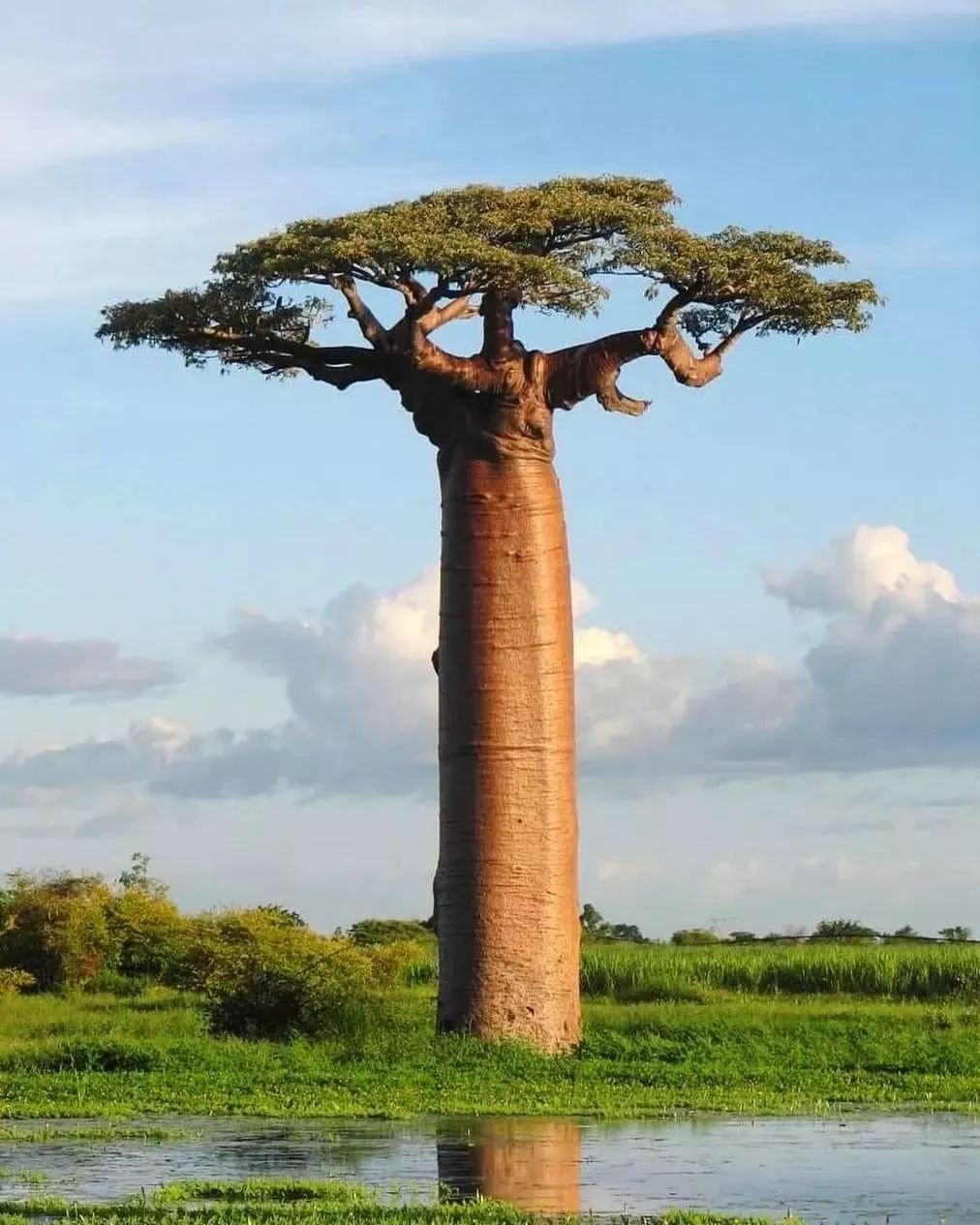
Here’s a short information chart about the Baobab tree (Adansonia):
| Common Name | Baobab |
|---|---|
| Scientific Name | Adansonia |
| Family | Malvaceae (previously Bombacaceae) |
| Native To | Africa, Madagascar, Australia and the Arabian Peninsula |
| Description | Iconic, large deciduous tree with a massive, swollen trunk and sparse, spreading branches; often referred to as the “upside-down tree” due to its unusual appearance |
| Height | Can reach up to 25 meters (82 feet) tall, with trunk diameters exceeding 10 meters (33 feet) |
| Leaves | Palmate leaves with 5-9 leaflets; shed during the dry season |
| Flowers | Large, white to creamy-yellow flowers that bloom at night, pollinated by bats and nocturnal insects |
| Fruit | Large, oblong fruit with a hard, woody shell containing powdery pulp and seeds; rich in vitamin C and other nutrients |
| Ecological Role | Provides food and habitat for various wildlife species; plays a crucial role in local ecosystems |
| Cultural Significance | Sacred tree in many African cultures; various parts used for food, medicine, and materials |
| Conservation Status | Some species are threatened due to habitat loss and climate change; conservation efforts are underway to protect them |
Baobab trees are some of the strangest-looking trees in the world. They have huge, thick trunks and branches that look like roots reaching up to the sky.
These trees grow in Africa and Australia. They can live for thousands of years and store water in their trunks to survive long dry seasons.
Baobab trees make fruits that people can eat. The fruit is full of vitamin C and tastes a bit like lemonade.
6. Bald Cypress (Taxodium distichum)
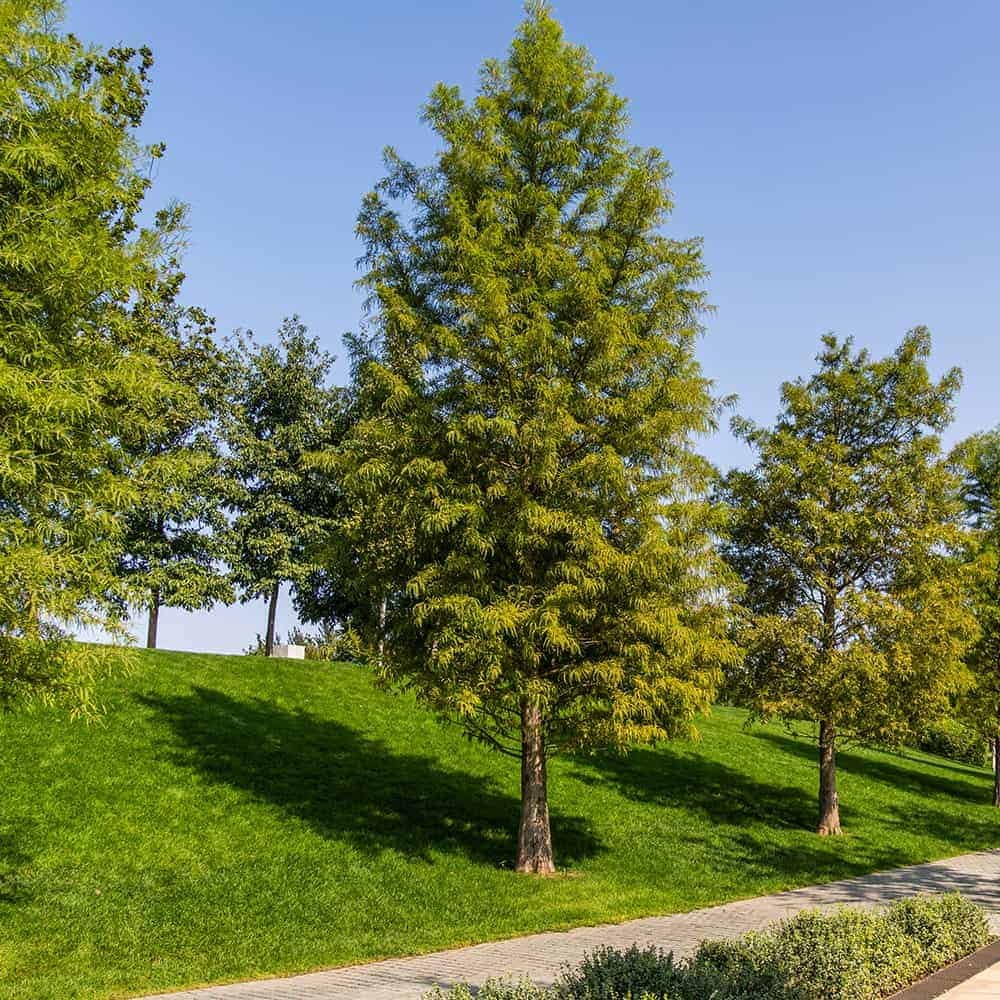
Here’s a short information chart about the Bald Cypress (Taxodium distichum):
| Common Name | Bald Cypress |
|---|---|
| Scientific Name | Taxodium distichum |
| Family | Cupressaceae |
| Native To | Southeastern United States and Mexico |
| Description | Deciduous conifer with a conical shape when young, becoming more columnar with age; distinctive “knees” (pneumatophores) protrude from roots in swampy habitats |
| Height | Typically grows 30-120 feet tall, with a trunk diameter of 3-6 feet |
| Leaves | Feathery, needle-like leaves that turn rusty brown in autumn and shed in winter |
| Cones | Small, round cones about 1 inch in diameter, containing seeds with small wings |
| Habitat | Thrives in wet, swampy areas, including floodplains, swamps, and along riverbanks |
| Wood | Valued for its rot-resistant qualities; used in construction, boat building, and outdoor furniture |
| Ecological Role | Provides habitat and food for various wildlife species; helps stabilize wetland ecosystems |
| Cultural Significance | Symbolic tree in some Native American cultures; popular ornamental tree in landscapes and gardens |
| Conservation Status | Generally secure, but habitat loss and urban development can threaten local populations |
Bald Cypress trees are special because they can grow in water. You often see them in swamps in the southern United States.
These trees have roots that stick up out of the water or soil. These are called “knees” and they help the tree breathe.
Bald Cypress trees lose their leaves in winter, which is unusual for a tree with needles. That’s why they’re called “bald”!
7. Banyan (Ficus benghalensis)
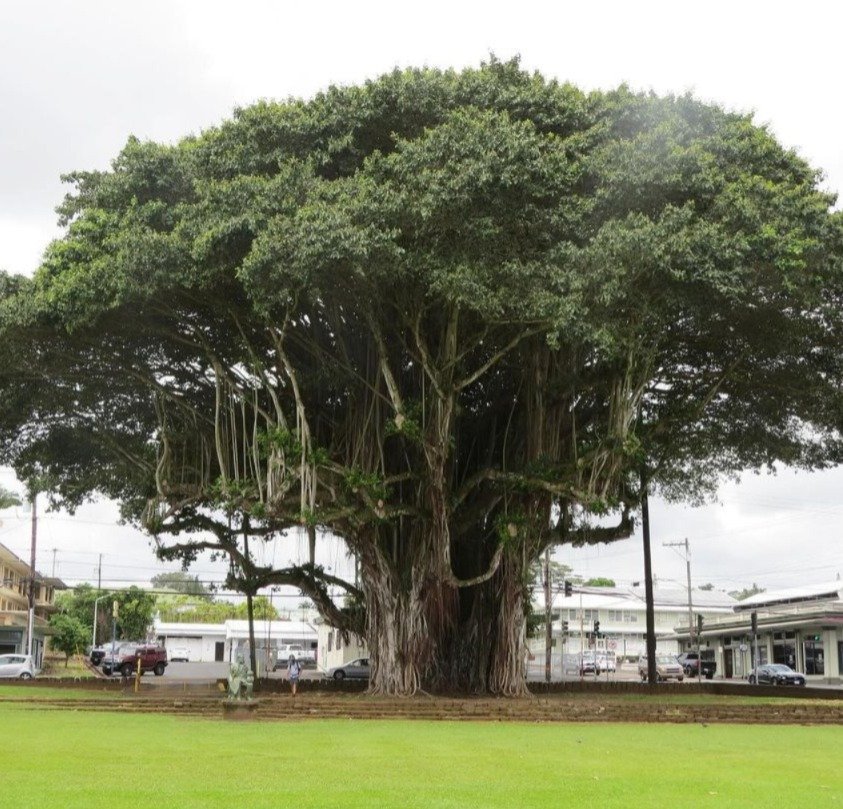
Here’s a short information chart about the Banyan tree (Ficus benghalensis):
| Common Name | Banyan |
|---|---|
| Scientific Name | Ficus benghalensis |
| Family | Moraceae |
| Native To | South Asia, particularly India, Pakistan, Sri Lanka, and Bangladesh |
| Description | Large, evergreen tree with a spreading canopy and aerial roots that grow into secondary trunks, giving it a distinctive appearance |
| Height | Can grow up to 30 meters (100 feet) tall, with a massive canopy that can spread over several acres |
| Leaves | Oval to elliptical, glossy green leaves; new leaves are reddish in color |
| Fruit | Small, round figs that ripen to reddish-orange or purple; important food source for birds and other wildlife |
| Ecological Role | Provides habitat for a wide variety of animals; plays a crucial role in maintaining biodiversity in its ecosystem |
| Cultural Significance | Sacred tree in Hinduism and Buddhism; often found near temples and considered a symbol of longevity and wisdom |
| Uses | Wood used in furniture and crafts; latex from the tree has traditional medicinal uses |
| Conservation Status | Generally not threatened in its native range, but deforestation and urbanization can impact local populations |
Banyan trees are amazing. They start growing on other trees or buildings and send roots down to the ground. These roots grow into new trunks, so one tree can spread out to look like a whole forest!
These trees are sacred in some parts of India. People sometimes meet under Banyan trees to talk or do business.
Banyan trees have large, heart-shaped leaves and make small figs that birds like to eat.
8. Basswood (Tilia)
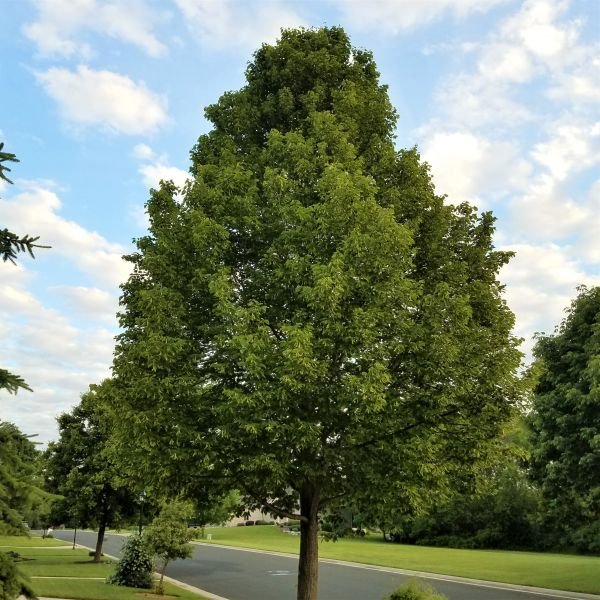
Here’s a short information chart about Basswood (Tilia):
| Common Name | Basswood |
|---|---|
| Scientific Name | Tilia |
| Family | Malvaceae (previously Tiliaceae) |
| Native To | Temperate regions of the Northern Hemisphere |
| Description | Deciduous tree with a straight trunk and dense, rounded crown; heart-shaped, serrated leaves |
| Height | Typically grows 60-80 feet tall, occasionally reaching up to 100 feet |
| Flowers | Fragrant, pale yellow to creamy-white flowers that hang in clusters |
| Fruit | Small nut-like fruits with winged seeds |
| Wood | Soft, light-colored wood with fine grain; used for carving, furniture making, and musical instruments like guitars |
| Ecological Role | Provides habitat and food for wildlife species; contributes to forest ecosystems |
| Cultural Significance | Historically used for medicine, food, and material for making rope and baskets |
| Conservation Status | Generally stable, but local populations may be affected by habitat loss and climate change |
Basswood trees, also called Linden trees, are loved by bees. Their small, sweet-smelling flowers make very good honey.
These trees have big, heart-shaped leaves. Their wood is soft and light, so people use it to make instruments and carvings.
Basswood trees are good for cities because they can handle pollution well.
9. Blue Spruce (Picea pungens)
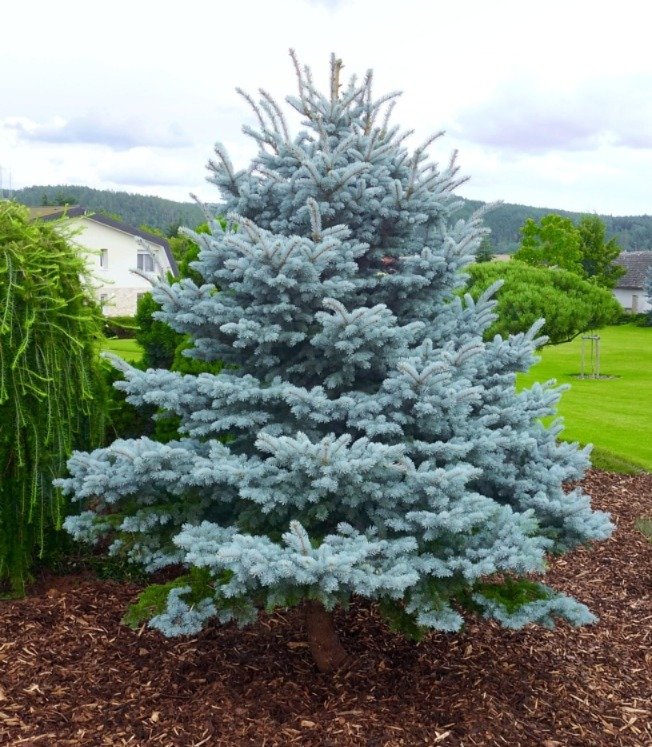
Here’s a short information chart about the Blue Spruce (Picea pungens):
| Common Name | Blue Spruce |
|---|---|
| Scientific Name | Picea pungens |
| Family | Pinaceae |
| Native To | Rocky Mountains of the United States (Colorado, Utah, Wyoming) |
| Description | Medium to large evergreen conifer with a conical shape when young, becoming more cylindrical with age; bluish-gray to silvery-blue needles |
| Height | Typically grows 30-60 feet tall, occasionally up to 100 feet |
| Cones | Cylindrical cones, 2-4 inches long, with thin scales and flexible bracts |
| Bark | Thin, scaly, and gray-brown in color, becoming thicker and furrowed with age |
| Ecological Role | Provides habitat and food for various wildlife species, particularly birds and squirrels |
| Wood | Not highly valued for timber due to its tendency to have numerous knots; used in specialty woodworking and as Christmas trees |
| Cultural Significance | Popular ornamental tree for landscapes and Christmas trees due to its striking color |
| Conservation Status | Generally stable in its native range, but localized threats can include pests and diseases |
Blue Spruce trees are famous for their pretty blue-green color. They’re shaped like perfect Christmas trees and stay green all year.
These trees have sharp needles and make long cones. They smell nice when you crush the needles.
Blue Spruce trees are often planted in yards and parks because they look so nice. They’re tough trees that can handle cold weather well.
10. Boxelder (Acer negundo)
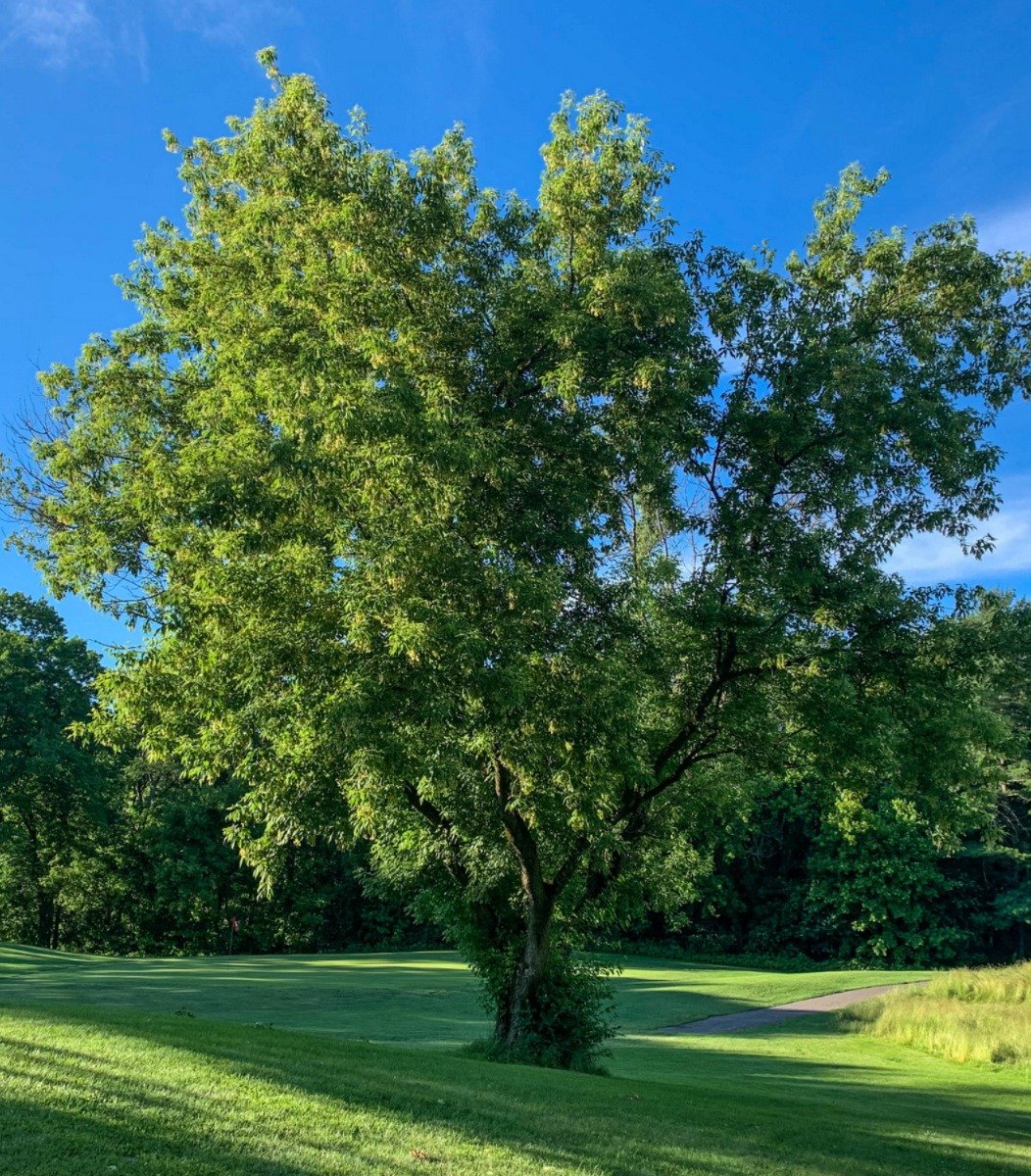
Here’s a short information chart about Boxelder (Acer negundo):
| Common Name | Boxelder |
|---|---|
| Scientific Name | Acer negundo |
| Family | Sapindaceae |
| Native To | North America |
| Description | Fast-growing deciduous tree or shrub with compound leaves divided into 3-7 leaflets; often multi-trunked |
| Height | Typically grows 30-50 feet tall, occasionally reaching up to 80 feet |
| Bark | Grayish-brown bark that becomes furrowed with age |
| Leaves | Opposite, compound leaves with serrated margins; turn yellow in autumn |
| Flowers | Inconspicuous, greenish-yellow flowers that appear in spring |
| Fruit | Small, winged samaras (seeds) clustered in drooping clusters |
| Ecological Role | Provides habitat and food for various wildlife species, including birds and small mammals |
| Wood | Soft and light; not typically used for lumber due to its low quality, but sometimes used for inexpensive furniture and pulp |
| Cultural Significance | Considered a weedy tree in some regions but valued for its ability to grow quickly and provide shade |
| Conservation Status | Not threatened; adaptable to various habitats but often considered a nuisance species in some areas |
Boxelder trees are part of the maple family. They grow fast and can live in many different places.
These trees have leaves made up of 3-7 smaller leaflets. They make seeds with wings that spin like helicopter blades when they fall.
Boxelder trees are good for wildlife. Many birds and small animals use them for food and shelter.
11. Butternut (Juglans cinerea)
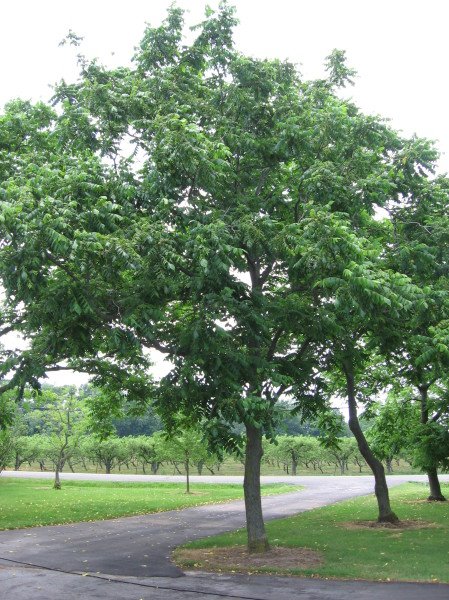
Here’s a short information chart about Butternut (Juglans cinerea):
| Common Name | Butternut |
|---|---|
| Scientific Name | Juglans cinerea |
| Family | Juglandaceae |
| Native To | Eastern North America |
| Description | Medium-sized deciduous tree with a spreading crown; compound leaves with 11-19 leaflets |
| Height | Typically grows 40-60 feet tall, occasionally up to 80 feet |
| Bark | Light gray-brown and smooth when young, becoming deeply furrowed and ridged with age |
| Leaves | Compound leaves with serrated margins; yellow-green in spring, turning yellow in autumn |
| Fruit | Oval-shaped nuts with deeply ridged husks; edible but less commonly consumed compared to black walnuts |
| Wood | Light to medium brown with a coarse texture; valued for woodworking, including furniture and cabinetry |
| Ecological Role | Provides food for wildlife, including squirrels and birds; contributes to forest ecosystems |
| Cultural Significance | Historically used by Native Americans and early settlers for food, dyes, and medicinal purposes |
| Conservation Status | Threatened by Butternut canker disease, impacting populations across its range |
Butternut trees are also called White Walnuts. They make nuts that taste a bit like walnuts but are more buttery.
These trees have long leaves made up of many leaflets. Their bark is gray and smooth when they’re young, but gets rougher as they grow older.
Sadly, many Butternut trees are sick with a disease called Butternut Canker. Scientists are working to save these trees.
12. Bigtooth Aspen (Populus grandidentata)
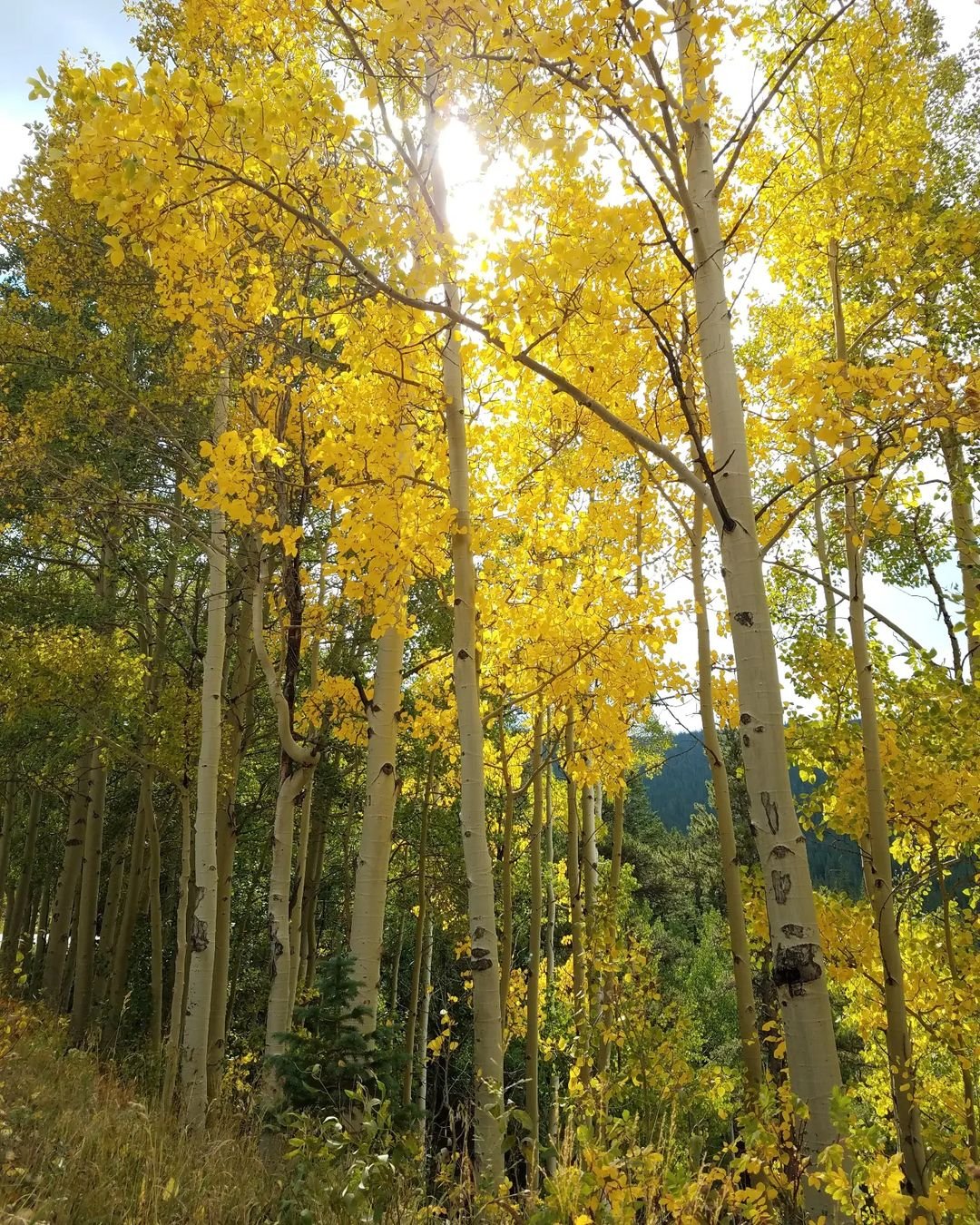
Here’s a short information chart about Bigtooth Aspen (Populus grandidentata):
| Common Name | Bigtooth Aspen |
|---|---|
| Scientific Name | Populus grandidentata |
| Family | Salicaceae |
| Native To | Eastern North America |
| Description | Medium-sized deciduous tree with a narrow, oval crown; leaves are broadly triangular with coarse teeth along the edges |
| Height | Typically grows 40-60 feet tall, occasionally reaching up to 80 feet |
| Bark | Smooth and greenish-gray when young, becoming gray and furrowed with age |
| Leaves | Broadly triangular with rounded bases; green in spring and summer, turning yellow in autumn |
| Flowers | Inconspicuous, catkin-like flowers that appear in early spring before the leaves |
| Fruit | Small, round capsules containing numerous tiny seeds attached to cottony fibers for wind dispersal |
| Wood | Soft and lightweight; used in pulpwood production, but not highly valued for lumber due to its relatively low strength |
| Ecological Role | Important pioneer species in disturbed areas; provides habitat and food for various wildlife species |
| Cultural Significance | Sometimes used in landscaping and for erosion control; historically used by Native Americans for making baskets and other crafts |
| Conservation Status | Generally stable, but susceptible to pests and diseases such as leaf spot and rust diseases |
Bigtooth Aspen trees get their name from their leaves. The edges of the leaves have big “teeth” or jagged points.
These trees grow fast and have smooth, greenish-white bark. Their leaves turn bright yellow in fall.
Bigtooth Aspens are good pioneer trees. This means they’re often the first trees to grow in areas that have been cleared or burned.
13. Black Cherry (Prunus serotina)
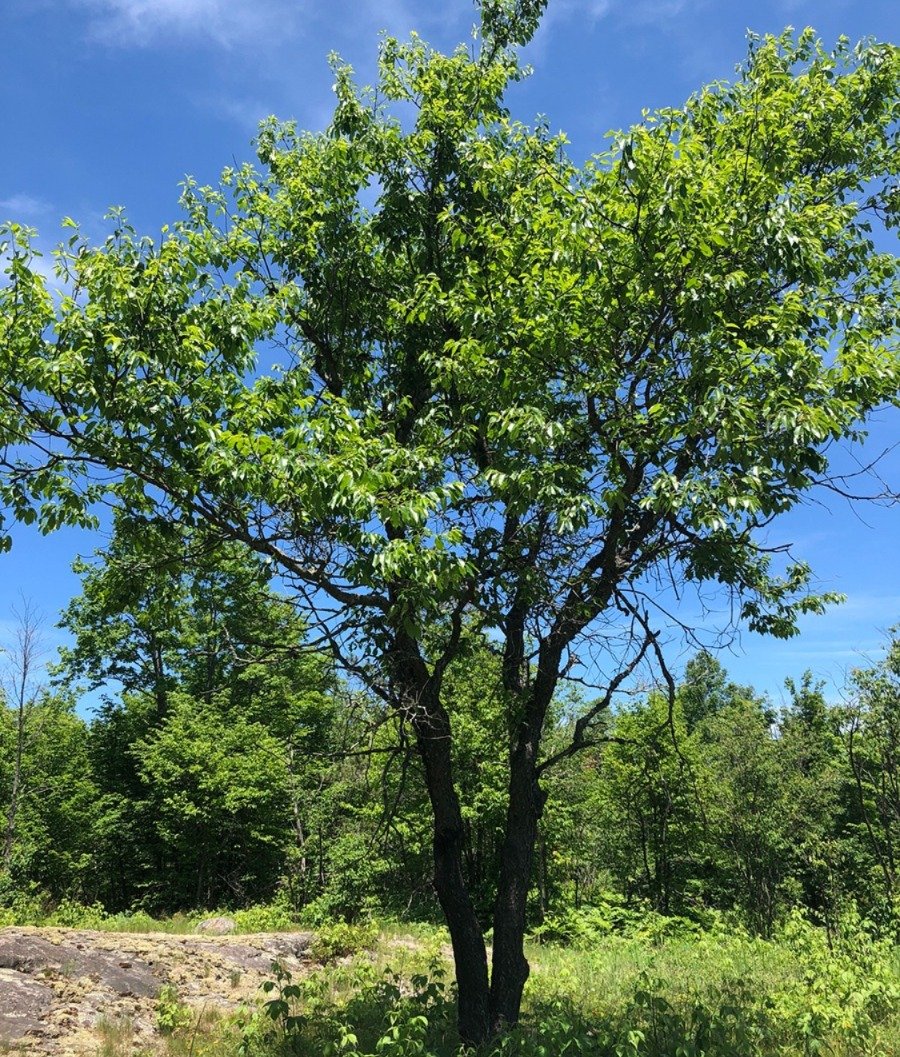
Here’s a short information chart about Black Cherry (Prunus serotina):
| Common Name | Black Cherry |
|---|---|
| Scientific Name | Prunus serotina |
| Family | Rosaceae |
| Native To | Eastern North America |
| Description | Medium to large deciduous tree with a narrow, pyramidal crown; smooth, reddish-brown bark that develops horizontal lenticels |
| Height | Typically grows 50-80 feet tall, occasionally reaching up to 100 feet |
| Leaves | Elliptical to lanceolate leaves with finely serrated margins; dark green and glossy above, paler below |
| Flowers | Fragrant, white flowers in elongated clusters (racemes) that appear in late spring |
| Fruit | Small, round berries (cherries) that are initially red and turn nearly black when ripe; important food source for wildlife |
| Wood | Hard, strong, and reddish-brown; valued for furniture making, cabinetry, and woodworking |
| Ecological Role | Provides food and habitat for wildlife, including birds and mammals; contributes to forest ecosystems |
| Cultural Significance | Cherries are edible but somewhat bitter; historically used in herbal medicine |
| Conservation Status | Common and not threatened; adaptable to various habitats but sensitive to logging practices and urbanization |
Black Cherry trees make small fruits that look like dark red or black cherries. Birds love to eat these fruits.
These trees have long, oval leaves with edges that look like they’ve been cut with pinking shears. The bark is dark and scaly.
The wood from Black Cherry trees is valuable. People use it to make furniture and cabinets.
14. Buttonwood (Platanus occidentalis)
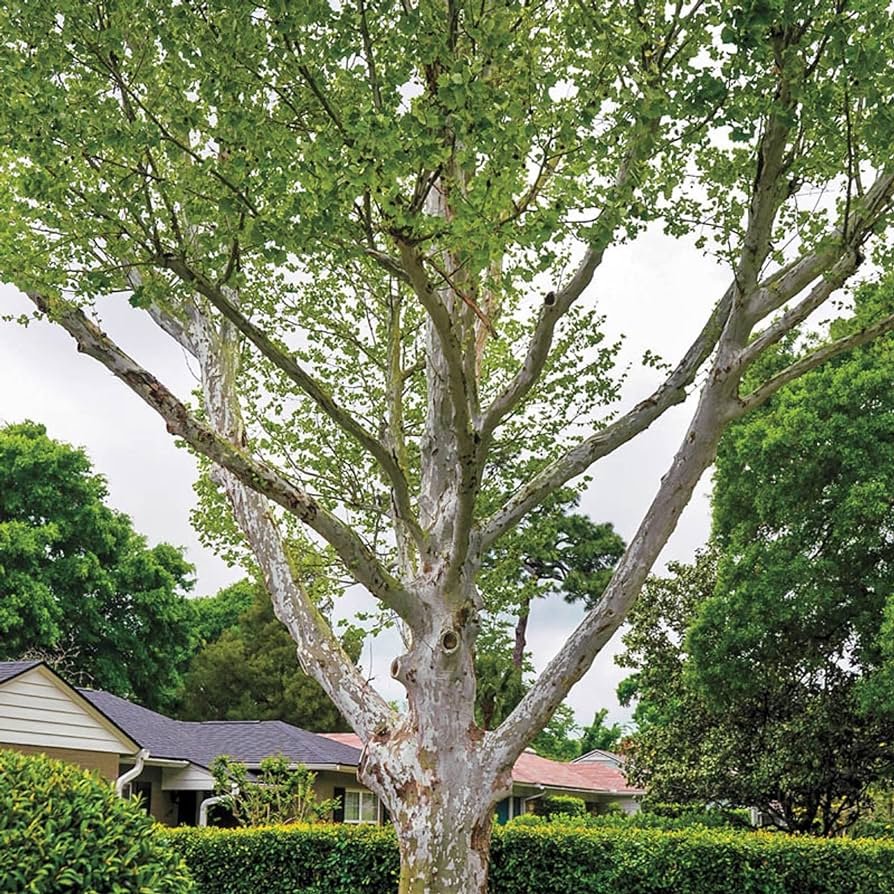
Here’s a short information chart about Buttonwood (Platanus occidentalis):
| Common Name | Buttonwood |
|---|---|
| Scientific Name | Platanus occidentalis |
| Family | Platanaceae |
| Native To | Eastern and central North America |
| Description | Large deciduous tree with a spreading canopy and distinctive mottled bark that sheds in irregular patches |
| Height | Typically grows 60-100 feet tall, occasionally reaching up to 130 feet |
| Leaves | Large, palmately lobed with 3-5 lobes; green in spring and summer, turning yellow in autumn |
| Flowers | Inconspicuous, greenish-yellow flowers that appear in spherical clusters |
| Fruit | Round, brownish fruits with small seeds that hang in clusters and persist into winter |
| Wood | Hard, durable and resistant to decay; historically used for butcher blocks, furniture, and tool handles |
| Ecological Role | Provides habitat for wildlife species; thrives in moist, riparian habitats along rivers and streams |
| Cultural Significance | Popular shade tree in urban landscapes and parks; historically used for medicinal purposes by Native Americans |
| Conservation Status | Generally stable; faces threats from habitat loss and urban development in some regions |
Buttonwood trees are also called American Sycamores. They’re easy to spot because their bark peels off to show white, tan and green patches underneath.
These trees make seed balls that look like buttons, which is how they got their name. The seed balls break apart in spring to spread seeds.
Buttonwood trees can get very big. Some are over 100 feet tall and have trunks more than 10 feet wide!
15. Bristlecone Pine (Pinus longaeva)
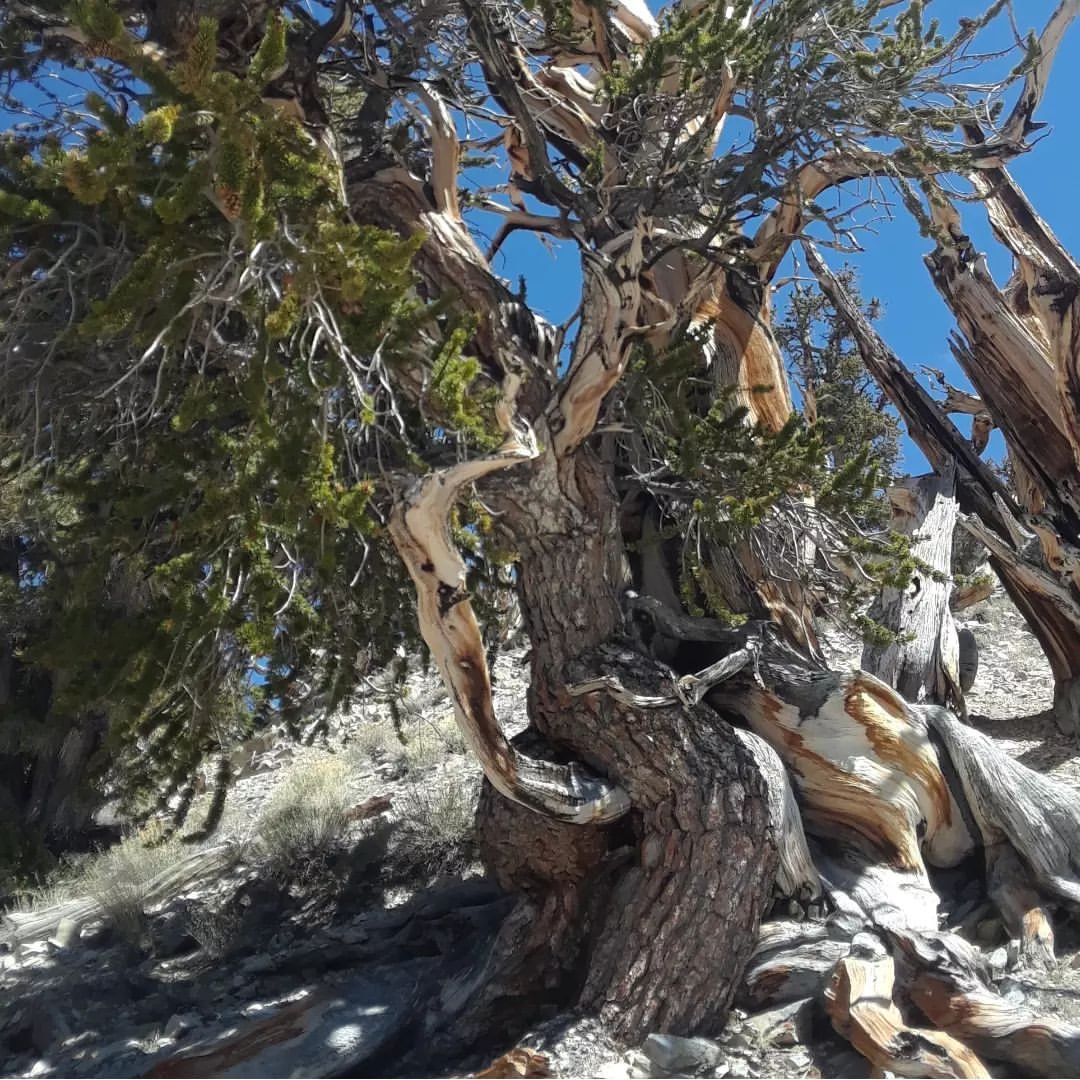
Here’s a short information chart about Bristlecone Pine (Pinus longaeva):
| Common Name | Bristlecone Pine |
|---|---|
| Scientific Name | Pinus longaeva |
| Family | Pinaceae |
| Native To | High mountain regions of the western United States, primarily in Nevada, California, and Utah |
| Description | Small to medium-sized evergreen tree with a gnarled and twisted appearance; needles are short and clustered in groups of five |
| Height | Typically grows 15-25 meters (50-80 feet) tall, with some individuals reaching up to 30 meters (100 feet) |
| Bark | Resinous and dark brown, often weathered and gnarled with age |
| Leaves | Evergreen needles, typically blue-green to dark green in color |
| Cones | Oval-shaped cones that are reddish-brown when mature, with thick scales and a sharp prickle (bristle) at the tip |
| Wood | Dense, durable, and resinous; not widely used commercially due to the trees’ protected status and slow growth |
| Ecological Role | Thrives in harsh, high-altitude environments; provides habitat and food for wildlife adapted to mountainous regions |
| Cultural Significance | Long-lived and symbolic of resilience and endurance; important to Native American cultures |
| Conservation Status | Some populations are protected due to their slow growth and vulnerability to climate change and human disturbance |
Bristlecone Pines are some of the oldest living things on Earth. Some of these trees are more than 4,000 years old!
These trees grow in tough places high in the mountains. They’re small and twisted from years of harsh weather.
Bristlecone Pines have short needles that grow in clumps. Their pinecones have bristles on the scales, which is how they got their name.
How to Plant and Care for ‘B’ Trees
Now that we know about these amazing ‘B’ trees, let’s talk about how to plant and care for them:
- Choose the right tree: Make sure the tree you pick will fit in your yard when it’s fully grown.
- Check your soil: Some trees like wet soil, others like dry soil. Test your soil to see what kind of tree will grow best.
- Plant at the right time: Spring and fall are usually the best times to plant trees.
- Dig a good hole: Make the hole twice as wide as the root ball, but not deeper.
- Water well: New trees need lots of water. Keep the soil moist but not soggy.
- Add mulch: Put a layer of mulch around your tree to keep the soil moist and stop weeds from growing.
- Prune carefully: Cut off dead or damaged branches to keep your tree healthy.
For more tree planting tips, visit the Arbor Day Foundation website.
Why Plant Trees?
Planting trees is good for many reasons:
- Trees clean our air by taking in carbon dioxide and giving out oxygen.
- They provide homes for birds and animals.
- Trees can help save energy by shading our homes in summer.
- They make our neighborhoods look nicer.
- Some trees give us fruit or nuts to eat.
- Trees can help stop soil from washing away in heavy rain.
Trees that start with ‘B’ are beautiful and amazing! From the big Beech to the twisted Bristlecone Pine, these trees make our world a better place.
When you plant a tree, you’re not just making your yard look nice. You’re helping the planet and future generations. So why not plant a ‘B’ tree today?
Remember, every tree needs care and love to grow strong. With a little effort, you can have a beautiful, healthy tree that will bring joy for years to come.
Whether you choose a big Banyan or a pretty Blue Spruce, you’re sure to find a ‘B’ tree that’s perfect for you. Happy planting!

